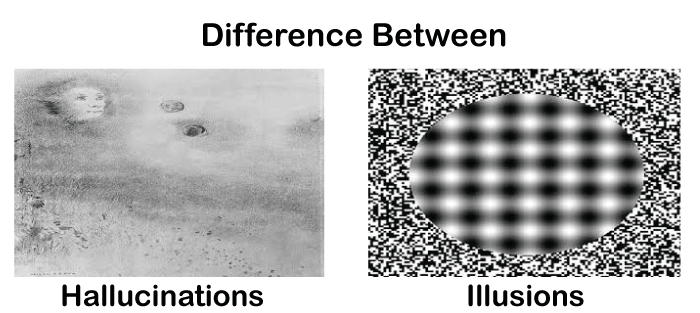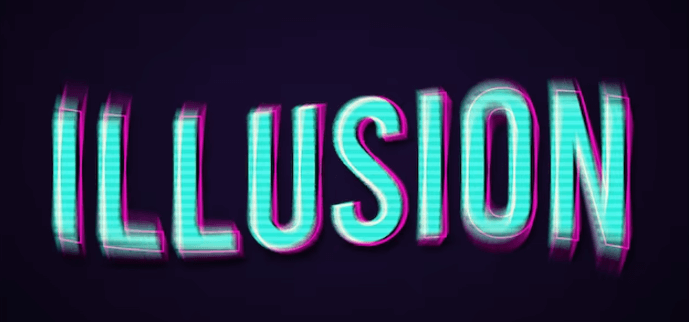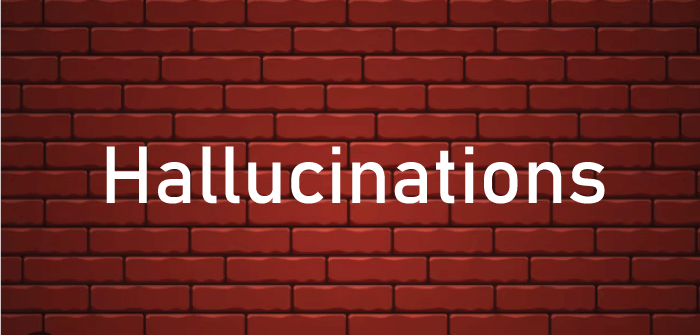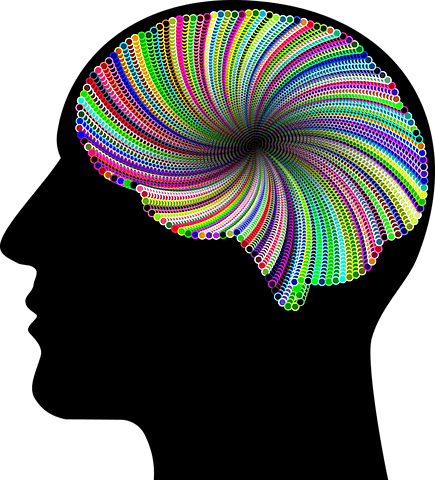Difference Between Illusion and HallucinationIllusions and hallucinations are two distinctive perceptual experiences that may happen in a variety of situations. Although they may appear identical at first glance, they have significant differences. A hallucination is a sense of something that is not truly present in the surroundings, whereas an illusion is a distorted or mistaken perception of real stimuli. 
An illusion is a sensory distortion that exposes how the mind organises and interprets sensory stimulation. While illusions affect people's perceptions of reality, most people experience them. Visual illusions (optical illusions) are among the most prevalent and recognized of the human senses. Because vision frequently dominates the other senses implies that visual illusions are emphasized. For example, People seeing a ventriloquist, will assume the voice is coming from the dummies because the dummy can be seen mouthing the words. While both can impact a person's understanding of reality and emotion, involvements to correct or recognize them as incorrect may differ depending on the underlying reason. Generally, distinguishing between illusions and hallucinations is essential for treating and diagnosing related medical or mental problems. IllusionA sensory distortion is described as an "illusion". Several illusions are based on broad assumptions made by the brain during perception. These assumptions are based on organizational concepts (for example, Gestalt theory), an individual's depth perception, observational abilities, and perceptual consistency. Some illusions are caused by biological sensory mechanisms within the human body or external factors in one's physical environment. A hallucination is a distortion that occurs when there is no stimulus present, whereas an illusion is a misperception of a real sensation. For example, hearing voices in any environment is a hallucination, while hearing voices in the sound of flowing water (or another auditory source) is an illusion. 
Some illusions are caused by illness or condition. While not everyone experiences these illusions, they are common in each situation. for example, Migraine sufferers, frequently describe fortification illusions. Some illusions are caused by illness or condition. While not everyone experiences these illusions, they are common in each situation. for example, Migraine sufferers, frequently describe fortification illusions. Types of Illusion
A visual illusion, often known as an optical illusion, is defined by visually perceived visuals that are false or deceptive. As a result, the information acquired by the visual sense is processed to produce, on the surface, a percept that contradicts information from other senses and physical measurement. A commonly assumed belief is that physiological illusions occur naturally. Cognitive illusions can be proved by specialized visual tricks revealing something more fundamental about human perceptual systems. Based on what it collects from the surrounding environment, the optical system (eye and brain) generates a reality within our heads. Yet, it attempts to organize this information " it thinks the best " at times while filling in the gaps at others. The way our brain operates is the foundation of an illusion.
An auditory illusion is a hearing illusion, the equivalent of a visual illusion, in which the listener perceives sounds that are not in the stimulus or "impossible" noises. In short, audio illusions highlight the points at which the human ear and brain depart from accurate audio receivers as organic, unplanned tools (for better or for worse). An example of an auditory illusion is a Shepard tone.
The phantom limb, cutaneous rabbit illusion, thermal grill illusion, and an odd illusion that occurs when the crossed index and middle fingers are ran along the bridge of the nose with one finger on each side, giving the sense of two separate noses, are examples of tactile illusions. The brain areas involved in false tactile perception are comparable to actual tactile stimulation. Haptic technology can also be used to create tactile illusions. These "illusory" tactile objects can produce "virtual objects."
A temporal illusion occurs when the interval between two or even more occurrences is relatively small (typically less than a second). In such instances, a person may experience a brief slowing, stopping, speeding up, or sprinting backward.
Other senses are notably those involved in food perception, can experience intersensory illusions. It has been discovered that sound and touch can alter the perceived staleness as well as the crispness of food. It was also observed that tactile stimulation might induce false taste even if some of the taste receptors on the tongue were destroyed. When positive or negative verbal labels were provided before olfactory stimulation, olfactory (smell) illusions were detected. The McGurk effect shows that what we see influences what we hear when someone talk; when one sound's auditory component is mixed with another's visible part, a perception of third sound is experienced. Symptoms of Illusion
HallucinationA hallucination is a perception that has the same qualities as a true perception but arises in the absence of an external stimulus. Hallucinations are vivid, real, and seen in objective exterior space. Hallucination is a conscious condition that combines cerebral alertness with REM sleep. They differ from several related phenomena, such as dreaming (REM sleep), which does not include wakefulness, pseudo-Hallucination, which is not similar to real perception and thus is accurately perceived as an unreal illusion that allows for distorted or misinterpreted real perception; and mental imagery, which does not mimic real perception and is under voluntary control. Hallucinations are also distinct from "delusional perceptions," which occur when a correctly perceived and interpreted stimulus (i.e., an actual perception) is given a further significance. Numerous hallucinations occur during sleep paralysis. 
Hallucinations can occur in every sensory modality, including vision, hearing, smell, taste, touch, proprioception, equilibrioception, nociceptive, thermoceptive, and conception. Multimodal hallucinations occur when many sensory modalities occur. A disturbance is a mild hallucination that can occur in most of the senses listed above. This could include seeing movement or hearing faint noises or conversations in your peripheral vision. Auditory hallucinations are a common sign of schizophrenia. They might be benevolent (telling the positive subject things about oneself) or malicious (cursing the subject). 55% of auditory hallucinations contain malicious content, such as others talking about the issue but not speaking to them directly. This might provide the impression that you are being watched or glared at, usually with malice. The individual frequently experiences auditory and visual hallucinations together. 
Both hypnagogic as well as hypnopompic hallucinations are considered common. When you go to sleep, you get hypnagogic hallucinations; when you wake up, you get hypnopompic hallucinations. Drug usage (especially deliriants), sleep deprivation, psychosis, neurological diseases, and delirium tremens can all cause hallucinations. The term "hallucination" was invented in 1646 by the 17th-century physician Thomas Browne, who derived this from the Latin word alucinari, which implies to wander in mind. According to Browne, hallucination is a type of vision that is "depraved and receive its things erroneously." A hallucination of one or more talking voices in a single person is typically related to psychotic diseases such as schizophrenia and has specific significance in identifying these ailments. Voices are generally thought to come from outside the individual with schizophrenia. Nevertheless, dissociative illnesses are thought to originate within the individual, commenting in their thoughts rather than behind their back. Because of the many similar symptoms, particularly Schneiderian first-rank symptoms like hallucinations, distinguishing schizophrenia from dissociative disorders is difficult. Types of Hallucination
A visual hallucination is defined as "the perception of external visual stimuli in the absence of any." A visual illusion is a distinct but similar phenomenon in which real external stimuli are distorted. Non-formed as well as elementary visual hallucinations are different names for simple visual hallucinations (SVH). These names indicate to lights, colors, geometric shapes, and indiscrete entities. They are further classified as phosphenes (SVH without structure) and photopsias (SVH with geometric forms). CVH (complex visual hallucinations) are also known as formed visual hallucinations. CVHs are clear, lifelike images or sceneries of people, animals, objects, or locations. For example, if a person says that he had an hallucination about giraffe. A simple visual hallucination involves an amorphous figure that appears like (resembles) a giraffe, whereas a sophisticated visual hallucination is a clear, lifelike image that is undeniably a giraffe.
The perception of sound in the absence of external stimulation is called auditory Hallucination (paracusia). Auditory hallucinations are classified as simple or complex, as well as verbal or nonverbal. The most prevalent types of hallucinations are auditory verbal hallucinations, which are more common than nonverbal hallucinations. Basic hallucinations include sounds like hissing, whistling, and constant tone. Tinnitus is frequently an elementary auditory hallucination. Yet, some people with tinnitus, particularly those with pulsatile tinnitus, can hear the blood running through vessels near the ear. In this case, the appearance of an aural signal does not classify it as a hallucination. Voices, music, or even other noises that can be clear, identifiable, friendly, aggressive, or any mix of these are examples of complex hallucinations.
Command hallucinations are hallucinations that take the form of commands and appear to come from an external source or from the subject's head. The hallucinations' contents can range from innocuous to commands to hurt oneself or others. Command hallucinations are frequently connected to schizophrenia.
Tactile hallucinations are the illusions caused by tactile sensory input that simulates various types of pressure on the skin or the other organs. Formication, a sort of tactile hallucination is the sense of insects crawling beneath the skin and is usually connected with long-term cocaine usage. Formication can, however, be caused by normal hormonal changes such as menopause, or by illnesses such as peripheral neuropathy, high temperatures, Lyme disease, skin cancer, and others.
These hallucinations include smelling things that are not really there. They might range from pleasant to unpleasant odours.
These are sensations in the body that are not actually occurring, such as the sensation that organs are moving or that the body is deforming. Symptoms of Hallucination
Facts about Illusion and Hallucination
Differences Between Illusion and Hallucination
Similarities Between illusion and Hallucination
ConclusionIn conclusion, while there are some similarities between illusions and hallucinations, they are unique perceptual experiences with significant differences. Misunderstanding sensory information causes illusions, whereas the brain produces hallucinations without true sensory input. Furthermore, hallucinations are frequently connected with more severe or particular medical or mental illnesses. Hallucinations and illusions are physiological and psychological states of the individual. A delirious person may believe their perceptual experiences are true and act accordingly. In contrast, illusions can be experienced by persons from diverse backgrounds and with various medical conditions. While both can impact a person's experience of reality and emotional state, interventions to correct or recognize them as incorrect may differ depending on the underlying reason. Generally, distinguishing between illusions and hallucinations is critical for diagnosing and treating linked medical or mental problems.
Next TopicDifference Between
|
 For Videos Join Our Youtube Channel: Join Now
For Videos Join Our Youtube Channel: Join Now
Feedback
- Send your Feedback to [email protected]
Help Others, Please Share










